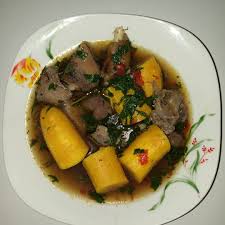Table of Contents
Goat meat pepper soup is a spicy, heartwarming dish native to West Africa, with its origins deeply rooted in Nigerian cuisine. It is enjoyed across many regions, with slight variations in preparation, but the essence of this dish remains the same—an explosion of flavors, heat, and nourishment.
Adding plantain to the pepper soup enhances the texture and provides a balance between the spicy broth and the slight sweetness of the unripe plantains. The plantains absorb the flavors of the broth and add a starchy element to the soup, making it more filling and perfect as a standalone meal.
In this extensive guide, we’ll walk you through each step of cooking the perfect goat meat pepper soup with plantain, exploring the ingredients, preparation techniques, variations, and frequently asked questions in much more detail.
Goat Meat Pepper Soup with Scent Leaves : Best of 2024
Goat Meat Pepper Soup: A Closer Look

Goat meat pepper soup is not just a dish; it’s a cultural experience. The spicy broth is believed to have medicinal properties, with ingredients like uziza, alligator pepper, and ginger, which are known for their healing and immune-boosting qualities. The dish is often prepared as a comfort meal during cold or rainy days, served at family gatherings, or offered as a dish of hospitality to guests.
Detailed Ingredients Breakdown for Goat Meat Pepper Soup with Plantain
Cooking a rich and flavorful goat meat pepper soup requires understanding the ingredients and how they contribute to the final taste of the dish. Here, we take a deeper look at each component.
1. Goat Meat (2 kg)
Goat meat, or chevon, is lean and gamey with a distinct taste that is crucial to the flavor of pepper soup. Goat meat is a staple in many African countries and is prized for its low-fat content and rich taste. The best part of using goat meat for this recipe is that you can mix various cuts, including bones, ribs, and fatty portions. Bones are especially important because they release collagen during the slow-cooking process, which adds depth to the broth.
For best results, source fresh goat meat from a trusted butcher. If available, you can ask for cuts that include parts like the neck, ribs, and even some skin, as these portions will release more flavor into the soup.
Preparation Tip: Always wash the goat meat thoroughly. After cleaning, it’s a good idea to blanch the meat by briefly boiling it in salted water to remove any impurities. This will help keep the broth clear and pure, which is important for the final presentation of your pepper soup.
2. Unripe Plantains (2 large)
Unripe plantains are a versatile starchy fruit, commonly used in West African cuisine. When used in soups like pepper soup, they retain their firmness and absorb the flavors of the broth. Unlike ripe plantains, unripe plantains have a subtle sweetness that complements the savory and spicy elements of the soup.
Plantains are rich in fiber, vitamins A, C, and B6, and are known to aid in digestion. The starchy texture of plantain makes it an excellent addition to pepper soup, giving it a hearty, satisfying feel.
Cooking Tip: Make sure to use firm, unripe plantains, as they are less likely to turn mushy during cooking. To peel them easily, cut off both ends and score the skin lengthwise before peeling it off with your hands.
3. Pepper Soup Spices (1 tablespoon)
Pepper soup spices are the heart of this dish. They typically consist of a blend of local spices, which include uziza seeds (Piper guineense), alligator pepper (Aframomum melegueta), calabash nutmeg (Monodora myristica), and other indigenous ingredients. Each of these spices brings a unique flavor profile that contributes to the warming and invigorating characteristics of the soup.
Uziza seeds are pungent and peppery, adding a strong, spicy kick to the dish. Alligator pepper, related to the ginger family, adds a warm heat and depth to the soup, while calabash nutmeg contributes a woody, slightly nutty aroma that enhances the complexity of the broth.
Preparation Tip: You can purchase a ready-made pepper soup spice mix from African grocery stores or markets. If you want to make your own, grind these spices fresh for the best flavor. Adjust the quantity according to your heat tolerance.
4. Scotch Bonnet Peppers (3-4 pieces)
Scotch bonnet peppers are known for their intense heat and fruity flavor, making them an essential part of West African cuisine. These peppers pack a punch, with heat levels ranging between 100,000 to 350,000 Scoville Heat Units (SHU). The vibrant spiciness they bring to the dish is one of the defining characteristics of goat meat pepper soup.
For those who prefer a milder version of the soup, you can reduce the number of Scotch bonnets or substitute with a milder pepper like cayenne or jalapeño.
Preparation Tip: Always wear gloves when handling Scotch bonnet peppers to avoid irritation. You can deseed the peppers to reduce their heat or leave the seeds in if you want the full spicy experience.
5. Onions (1 large)
Onions add a natural sweetness and depth to the broth. As the onions cook, they break down and blend with the pepper soup spices, enhancing the richness of the broth. Onions are also high in antioxidants, which have anti-inflammatory properties, making them a perfect complement to the other spices.
Preparation Tip: Chop the onions finely to ensure they dissolve easily into the broth. You can also blend half of the onion with the Scotch bonnet peppers for a smooth texture and a balanced flavor.
6. Crayfish (1 tablespoon, ground)
Crayfish is a popular ingredient in Nigerian cuisine and adds a distinct umami flavor to the soup. Ground crayfish introduces a savory, slightly sweet note that pairs wonderfully with the goat meat. It also enriches the broth, adding depth and a subtle seafood essence.
If fresh crayfish is unavailable, dried crayfish or shrimp powder can be used as an alternative. However, the flavor profile will change slightly with dried seafood.
Cooking Tip: Add the ground crayfish toward the end of the cooking process to preserve its delicate flavor.
7. Garlic (3 cloves, minced)
Garlic offers a punch of flavor that pairs well with ginger and the pepper soup spices. Its strong, aromatic qualities enhance the overall richness of the broth, balancing the heat and spice.
Health Benefits: Garlic is rich in allicin, a compound known for its antibacterial, antiviral, and antifungal properties. Including garlic in pepper soup not only boosts flavor but also contributes to the soup’s health benefits, making it a great choice during cold or flu season.
8. Ginger (1-inch piece, grated)
Ginger is another key ingredient that adds warmth and complexity to the soup. Its peppery and slightly sweet flavor blends harmoniously with the spices and goat meat. Ginger is also known for its digestive benefits and anti-inflammatory properties, which make it an essential addition to many Nigerian soups.
Cooking Tip: Use fresh ginger for the best flavor. Grate or finely chop the ginger to allow it to dissolve into the broth and release its full flavor.
9. Bouillon Cubes (2)
Bouillon cubes are concentrated flavor enhancers made from broth, salt, and seasonings. In Nigerian cooking, bouillon cubes (such as Maggi or Knorr) are used to add a rich, savory taste to soups and stews. They help deepen the flavor of the broth, making it more robust.
Tip: While bouillon cubes add a lot of flavor, be cautious of adding too much salt to the soup, as the cubes are already salty. Always taste the soup before adding extra salt.
10. Water (2 liters)
Water forms the base of your pepper soup. The amount of water used will determine the thickness of the soup, so adjust it based on your preference. Some people prefer a more watery pepper soup, while others enjoy a thicker, more concentrated broth.
Tip: Start with 2 liters and add more as needed, especially if you find that the soup is too thick after adding the plantains.
11. Salt (to taste)
Salt is essential for bringing out the flavors of the other ingredients. Add salt gradually, tasting as you go, to ensure the seasoning is balanced.
12. Scent Leaves (1 cup, chopped)
Scent leaves, also known as “nchuanwu” or “efinrin,” are a fragrant herb used in West African cuisine. They are similar to basil and add a refreshing, aromatic quality to the soup. Scent leaves are typically added toward the end of the cooking process to preserve their flavor and aroma.
If you can’t find scent leaves, you can substitute with fresh basil, although the flavor will not be exactly the same.
How to Cook Goat Meat pepper soup best Recipe of 2024
Step-by-Step Expanded Cooking Process (Goat meat Pepper soup)
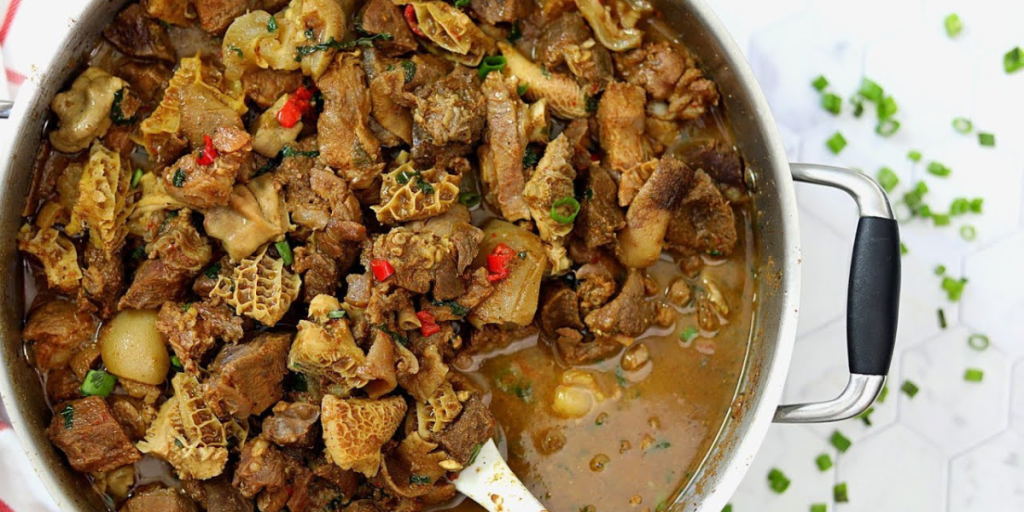
1. Preparing the Ingredients
After gathering all your ingredients, it’s time to prep them for cooking. As mentioned earlier, it’s important to wash and clean the goat meat thoroughly. Goat meat, like most game meats, can have a strong odor, so cleaning it well will ensure a fresh taste.
One trick often used in West African households is soaking the goat meat in lime or lemon juice before rinsing. This helps to neutralize any strong odors and also tenderizes the meat slightly.
For the plantains, peeling them can be tricky if you’ve never worked with unripe plantains before. Cutting off the tips and scoring the peel makes the process easier.
2. Boiling the Goat Meat
Once your goat meat is prepped, place it in a large pot, add water, and bring it to a boil. Add half of your chopped onions, garlic, ginger, and some salt at this point to begin infusing flavor into the meat as it boils.
Cook the goat meat on medium heat until it becomes tender. Depending on the cut and freshness of the meat, this process can take anywhere from 45 minutes to an hour. The goal is to make sure the meat is tender enough to fall off the bone but not so soft that it disintegrates in the soup.
Tip: If you’re using an older goat, which tends to have tougher meat, consider adding a teaspoon of baking soda to the water. This can help to tenderize the meat more quickly.
3. Blending the Peppers and Spices
While the meat is cooking, blend your Scotch bonnet peppers with the remaining onions and a little water until smooth. This will help distribute the heat evenly throughout the broth and ensure that the pepper flavor permeates every bite of the soup.
Next, prepare your pepper soup spice mix. If you’re using whole spices, grind them into a fine powder using a spice grinder or mortar and pestle.
4. Adding the Pepper Soup Spices
Once the goat meat is nearly tender, it’s time to add your pepper soup spices, blended peppers, and bouillon cubes. Stir well to combine, making sure the spices are evenly distributed throughout the broth.
Reduce the heat to a gentle simmer and allow the soup to cook for an additional 10-15 minutes. This allows the spices to meld together and infuse the broth with their rich, complex flavors.
5. Adding the Plantains
Once the soup base has had time to simmer and the goat meat is tender, it’s time to add the plantains. The plantains will not only add substance to the dish but will also absorb the spicy and savory flavors of the broth, adding a rich, starchy element to the pepper soup.
Cut the peeled plantains into medium-sized chunks, around 1 to 2 inches in length. The size of the chunks is important, as you want them to hold their shape throughout the cooking process. Adding the plantains too early or cutting them too small could cause them to become mushy or dissolve into the soup.
Place the plantain chunks into the soup and stir gently to make sure they are well submerged. Simmer the soup on medium heat for an additional 10-15 minutes, or until the plantains are cooked through. You can test their doneness by piercing a piece with a fork. It should be soft but not falling apart.
Tip: If you prefer a thicker broth, you can slightly mash one or two pieces of the plantain in the pot. This will release some of the plantain starch into the soup, naturally thickening it without the need for additional ingredients like cornstarch or flour.
6. Adjusting the Seasoning
After the plantains are cooked, it’s time to adjust the seasoning of your soup. Taste the broth and check for balance. Does it have enough salt? Are the spices strong enough, or would you like more heat from the pepper? Now is the time to add more Scotch bonnet pepper if you want a spicier kick, or more pepper soup spice mix for a richer flavor.
Be mindful of how strong the flavor of the spices becomes as the soup reduces. Goat meat pepper soup has a bold taste, but it should still be balanced between spicy, savory, and fragrant notes. Stir well after adding any additional seasoning and let the soup simmer for another 5 minutes to allow the new flavors to meld together.
7. Adding the Scent Leaves
Finally, it’s time to add the chopped scent leaves. Scent leaves should be added toward the end of the cooking process to preserve their fresh, aromatic qualities. Stir them into the soup gently and let them cook for an additional 3-5 minutes. This will infuse the broth with the fresh, slightly minty aroma that complements the spice and heat of the pepper soup.
If you are using basil as a substitute, follow the same method of adding it in at the last minute, just before serving. Fresh herbs like scent leaves and basil can lose their flavor and vibrant color if they are cooked for too long, so be careful not to let them simmer for more than a few minutes.
8. Serving Goat Meat Pepper Soup with Plantain
Goat meat pepper soup is best served hot, fresh from the stove. The peppery heat and rich broth are perfect for cool weather or when you’re feeling under the weather, as the spicy ingredients are believed to help clear congestion and boost the immune system.
You can serve the soup in individual bowls, making sure each portion contains a good amount of goat meat, plantains, and broth. For added texture, you can garnish each bowl with additional chopped scent leaves or a sprinkle of ground crayfish.
Goat meat pepper soup with plantain can be enjoyed as a meal on its own, especially with the addition of the plantains, but it also pairs well with a variety of side dishes. Some popular accompaniments include:
- White rice: A mild side dish that balances out the spiciness of the soup.
- Yam: Boiled or fried yam can be served alongside the soup for extra texture and starch.
- Eba or Fufu: Starchy, dough-like sides made from cassava flour are great for dipping into the soup and soaking up the broth.
- Bread: A crusty loaf of bread is perfect for mopping up the flavorful broth.
Simple Meal for dinner in usa Best Of 2024
Nutritional Value of Goat Meat Pepper Soup with Plantain(Goat meat Pepper soup)
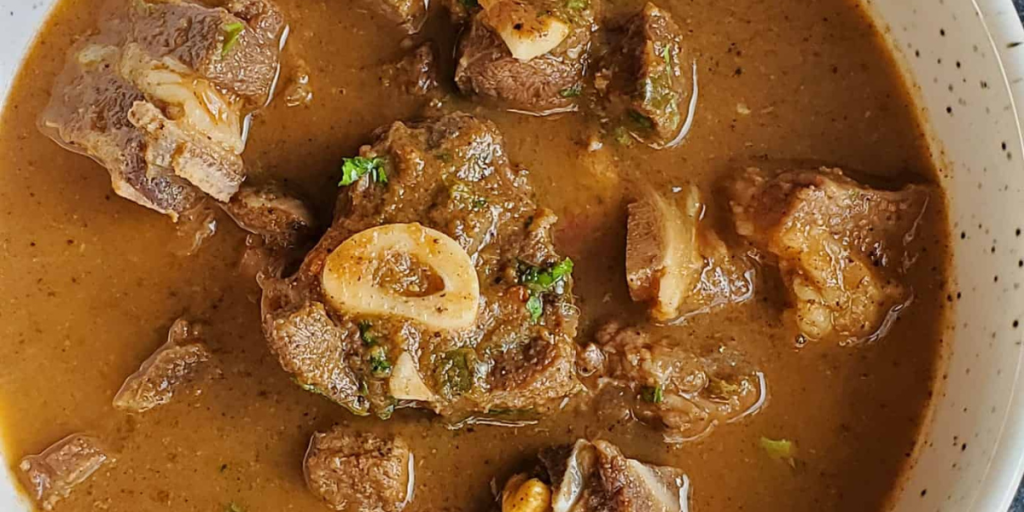
One of the reasons goat meat pepper soup is beloved in many West African homes is its health benefits. The ingredients used in this soup not only provide flavor but also carry a variety of nutritional properties.
Goat Meat
Goat meat is a lean source of protein, containing less fat and cholesterol than beef, pork, or lamb. It’s also rich in essential nutrients like iron, potassium, and vitamin B12, making it a good choice for individuals looking to boost their intake of healthy, nutrient-dense protein.
Additionally, goat meat is high in taurine, which supports cardiovascular health, and selenium, a mineral that plays a critical role in the immune system and thyroid function.
Plantains
Plantains, especially when unripe, are rich in dietary fiber, which aids digestion and helps regulate blood sugar levels. They are also an excellent source of vitamins A and C, both of which are important for maintaining healthy skin, eyes, and immune function.
Unripe plantains are particularly valued for their complex carbohydrates, which provide a slow and steady release of energy, making them a great choice for a hearty meal.
Pepper Soup Spices
The spices used in pepper soup, such as alligator pepper and calabash nutmeg, are packed with antioxidants and anti-inflammatory compounds. These spices are believed to have medicinal properties that can help with digestion, circulation, and overall immune health.
For instance:
- Alligator pepper is traditionally used for its antimicrobial and digestive benefits.
- Uziza seeds are known for their analgesic properties, providing relief from pain and inflammation.
- Ginger and garlic both have well-documented anti-inflammatory and immune-boosting effects.
Scotch bonnet peppers, which give the soup its characteristic heat, are rich in capsaicin, a compound known for its metabolism-boosting and anti-inflammatory properties. Capsaicin is also effective at clearing nasal congestion, making pepper soup an ideal dish for treating colds or flu symptoms.
Best Meal for Dinner in usa 2024
Variations of Goat Meat Pepper Soup with Plantain
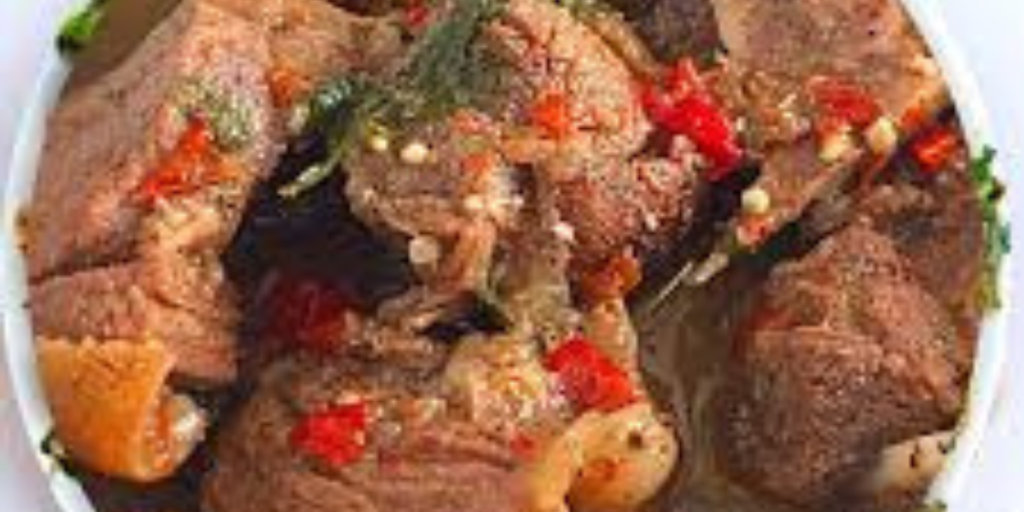
While the traditional method for making goat meat pepper soup with plantain is always a favorite, there are several variations you can try to customize the dish to your liking. Here are a few ideas to inspire creativity in the kitchen:
1. Goat Meat Pepper Soup with Yam Instead of Plantain
If you don’t have access to plantains or simply want to try a different texture, you can replace the plantains with yam. Yam has a denser, creamier texture when boiled, which gives the soup a slightly different mouthfeel.
Cut the yam into small cubes and add it to the soup in the same way you would with plantains. Keep in mind that yam may take a little longer to cook, so add it to the pot earlier if needed.
2. Mixed Meat Pepper Soup
For an even heartier version of the dish, consider using a combination of meats instead of just goat meat. You can mix goat meat with beef, oxtail, or cow tripe (shaki) for a more diverse range of textures and flavors.
Each type of meat will contribute a unique taste to the soup, with tripe adding chewiness and oxtail giving the broth an extra richness. Just remember that some cuts of meat, like oxtail, may require longer cooking times, so adjust your cooking process accordingly.
3. Fish Pepper Soup with Plantain
Another popular variation in Nigeria is fish pepper soup. You can substitute the goat meat with catfish or tilapia for a lighter version of the dish. Fish pepper soup with plantain is equally delicious and has a more delicate, subtle flavor compared to the heartier meat-based version.
When using fish, it’s important to be gentle when stirring the soup to avoid breaking the fish apart. Catfish, in particular, can be fragile once cooked, so handle with care.
4. Vegetable Goat Meat Pepper Soup
To add more color and nutrition to your goat meat pepper soup, consider incorporating leafy greens. Scent leaves are traditionally used, but you can also add vegetables like spinach, kale, or ugu (fluted pumpkin leaves).
Adding greens will enhance the nutritional value of the soup, providing extra vitamins and minerals, while also giving the dish a fresh, vibrant look. Add the greens during the last few minutes of cooking to keep them from wilting too much.
Best Meal for Dinner in usa 2024
Frequently Asked Questions About Goat Meat Pepper Soup with Plantain
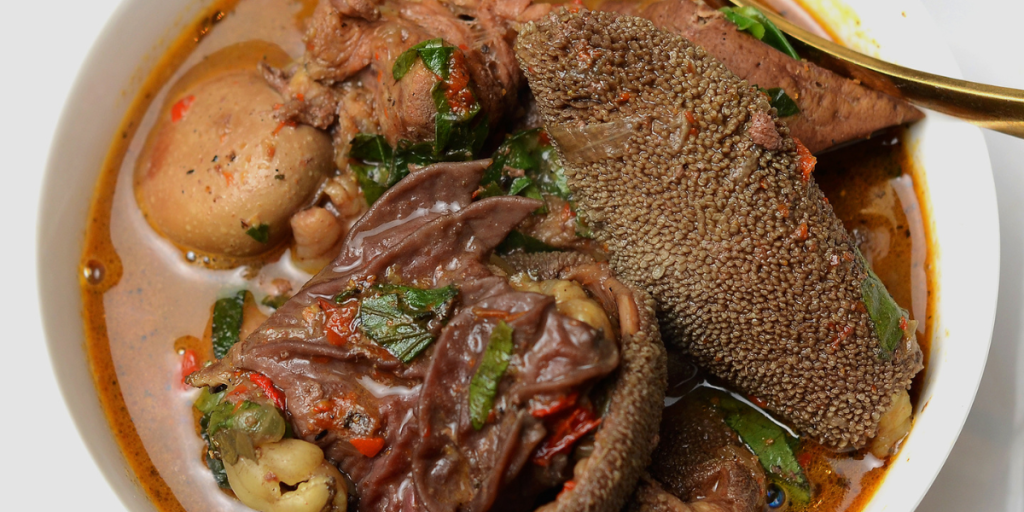
Here are some common questions people have when preparing goat meat pepper soup with plantain:
1. Can I make goat meat pepper soup with ripe plantains?
Yes, but the flavor and texture will be quite different. Ripe plantains are sweeter and softer, which can alter the balance of the dish. If you prefer a sweeter contrast to the spicy broth, you can use ripe plantains, but they may fall apart more easily in the soup.
2. How can I make the soup less spicy?
If you want to tone down the heat of the pepper soup, you can reduce the amount of Scotch bonnet pepper or substitute it with a milder variety. Deseeding the Scotch bonnet peppers can also reduce their heat, as the seeds contain a significant amount of capsaicin, the compound responsible for their spiciness.
3. Can I freeze goat meat pepper soup?
Yes, goat meat pepper soup freezes well. Allow the soup to cool completely before transferring it to an airtight container. It can be stored in the freezer for up to 3 months. When reheating, you may need to add a little water to restore the broth’s consistency.
4. What other sides can I serve with goat meat pepper soup?
In addition to rice, yam, or fufu, you can serve the soup with sides like boiled potatoes, bread, or couscous. The hearty broth pairs well with a wide range of starchy sides, making it a versatile dish for different preferences.
5. Can I use goat head or goat feet in the soup?
Yes, you can use goat head or goat feet in pepper soup for added flavor and texture. Goat head, in particular, is considered a delicacy in many African cuisines and contributes to the richness of the broth. Just keep in mind that these parts may take longer to cook than regular goat meat.
6. Can I make this soup with frozen goat meat?
Yes, you can use frozen goat meat for your pepper soup. However, it’s important to properly defrost the meat before cooking to ensure even cooking and full flavor absorption. The best way to thaw frozen goat meat is to leave it in the refrigerator overnight or, if you’re short on time, place it in a sealed plastic bag and submerge it in cold water. Avoid thawing goat meat in the microwave, as it can begin cooking unevenly.
7. Can I use dried pepper instead of fresh Scotch bonnet?
Yes, you can use dried pepper if fresh Scotch bonnet isn’t available. Ground cayenne pepper or dried chili flakes can be used as substitutes, but be mindful of the spice level and adjust according to your preference. Fresh Scotch bonnet gives a more distinct and intense heat, but dried peppers can still provide the necessary spice if needed. You can start with a small amount and add more to taste.
8. How do I prevent the plantains from becoming too mushy?
The key to keeping the plantains firm in the soup is to add them towards the end of the cooking process and cut them into larger chunks. Unripe plantains tend to be firmer, so using them ensures that they hold up well in the broth. Avoid stirring too vigorously once the plantains are added to the pot, as this can break them apart. Another tip is to keep the heat at a simmer rather than a rolling boil when cooking the plantains, which will prevent them from becoming overly soft.
9. Is goat meat pepper soup with plantain gluten-free?
Yes, goat meat pepper soup with plantain is naturally gluten-free, as it doesn’t contain any wheat or gluten-based ingredients. This makes it an excellent option for those who have celiac disease or gluten sensitivities. Just be sure to check that any bouillon cubes or pre-packaged spices you use are certified gluten-free, as some may contain trace amounts of gluten.
10. How can I reduce the cooking time for goat meat pepper soup?
To cut down on the cooking time, you can use a pressure cooker or Instant Pot. These devices are excellent for tenderizing tough cuts of meat like goat in a fraction of the time it takes using a stovetop. Simply cook the goat meat under high pressure for about 25-30 minutes, then release the pressure, and continue with the remaining steps of the recipe (adding spices, plantains, etc.). Using a pressure cooker can significantly reduce the time it takes to achieve tender, flavorful goat meat without sacrificing quality.
Cultural Significance of Goat Meat Pepper Soup
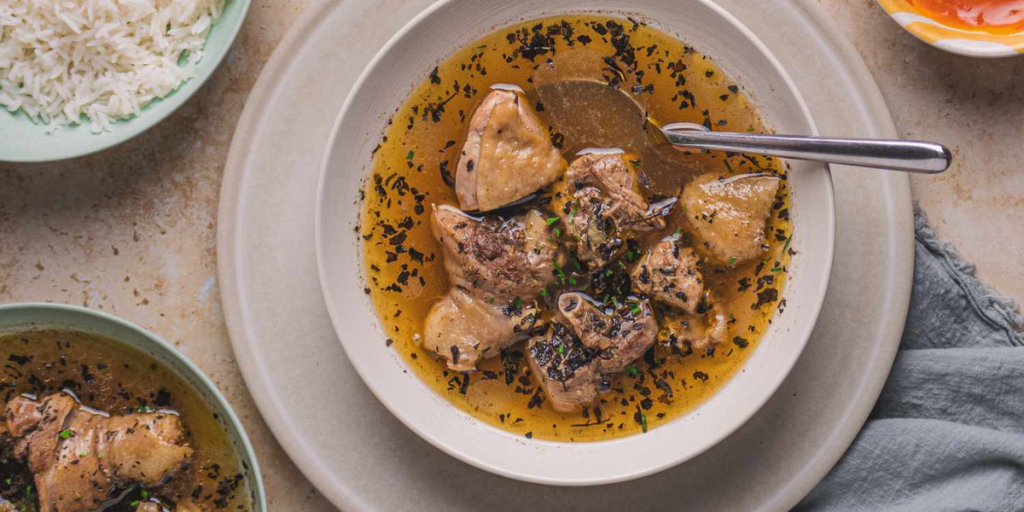
Goat meat pepper soup isn’t just a flavorful dish; it also holds cultural significance in many parts of West Africa, particularly in Nigeria. It’s a dish that is often associated with celebrations, family gatherings, and hospitality.
1. A Dish for Celebrations
In Nigerian culture, pepper soup is a popular choice for special occasions such as weddings, naming ceremonies, and festive holidays. The rich and spicy broth, combined with tender goat meat, makes it a dish that is both comforting and festive. It is commonly served to guests as an appetizer or main course at large gatherings, where it is enjoyed for its robust flavors and heartwarming properties.
2. A Comforting Meal
Pepper soup, in general, is considered a comforting meal, often given to people who are recovering from illness or childbirth. The combination of warming spices and nutritious broth is thought to promote healing and provide nourishment. The soup’s spicy nature also helps to relieve nasal congestion and sore throats, making it a go-to dish for treating colds and flu.
3. A Social Meal
Goat meat pepper soup is often enjoyed as a social dish, particularly in informal settings like bars and local eateries known as “bukas.” It is common to see people gather to enjoy bowls of pepper soup with a drink, such as palm wine or a cold beer. The dish has a social and communal aspect, bringing people together to share a meal and conversation.
Health Benefits of Goat Meat Pepper Soup
Goat meat pepper soup is not only delicious, but it also offers several health benefits, thanks to the nutritional profile of its ingredients. Here’s a breakdown of some of the health benefits you can expect from enjoying this dish.
1. High in Lean Protein
Goat meat is an excellent source of lean protein, making it a healthier alternative to red meats like beef and pork. Protein is essential for muscle repair, immune function, and overall body maintenance. A serving of goat meat provides all the essential amino acids your body needs for optimal health, without the high levels of fat and cholesterol found in other meats.
2. Rich in Iron
Goat meat is high in iron, an essential mineral that helps transport oxygen throughout the body and supports energy production. Iron is particularly important for preventing anemia, a condition characterized by fatigue and weakness due to low levels of red blood cells. The iron content in goat meat makes it an especially good choice for individuals who need to boost their iron intake, such as pregnant women or those with iron deficiencies.
3. Promotes Heart Health
Because goat meat is lower in fat and cholesterol than many other types of meat, it is a heart-healthy choice. Consuming goat meat can help maintain healthy cholesterol levels and reduce the risk of cardiovascular diseases. Additionally, the spices used in pepper soup, such as garlic, ginger, and alligator pepper, are known for their heart-healthy properties, including reducing inflammation and improving blood circulation.
4. Supports Digestive Health
The spices in goat meat pepper soup, particularly alligator pepper and ginger, are known for their digestive benefits. These spices help to stimulate digestion, reduce bloating, and alleviate indigestion. The fiber content from plantains also promotes a healthy digestive system by supporting regular bowel movements and preventing constipation.
5. Boosts Immunity
The ingredients in goat meat pepper soup, including garlic, ginger, and Scotch bonnet peppers, are packed with immune-boosting properties. Garlic and ginger contain compounds that have been shown to enhance immune function and fight off infections. Capsaicin, the compound responsible for the heat in Scotch bonnet peppers, has anti-inflammatory and antimicrobial properties that can help the body ward off illness.
Conclusion
Goat meat pepper soup with plantain is a quintessential West African dish that combines bold flavors, tender meat, and nutrient-rich ingredients. It is a versatile dish that can be adapted to suit different tastes and preferences, whether you prefer more or less spice, different cuts of meat, or variations in the type of starchy accompaniments like plantains or yams.
Beyond its rich taste, goat meat pepper soup offers a variety of health benefits, from its lean protein content to its immune-boosting spices. Whether you’re serving it at a family gathering, enjoying it as a comforting meal during cold weather, or using it to nourish yourself during recovery, this dish brings both flavor and nutrition to the table.
Incorporating the knowledge of the right ingredients, cooking techniques, and cultural significance of this dish can elevate your culinary skills and give you a deeper appreciation for the flavors and traditions of West Africa. Goat meat pepper soup with plantain is not just a meal; it’s a celebration of heritage, community, and wellness. So the next time you’re craving something hearty, spicy, and satisfying, give this recipe a try, and savor every bite of this flavorful dish.
















